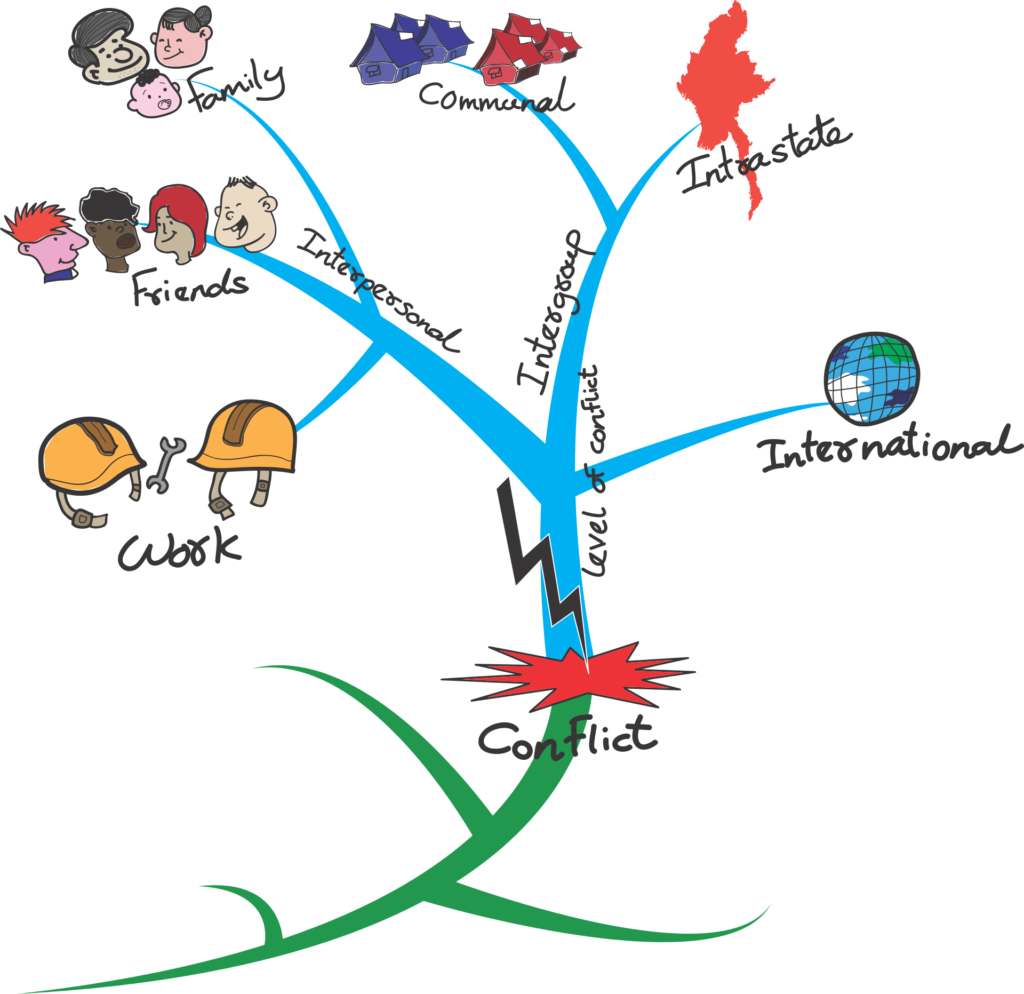While searching my PC files I found this article from 2012 and am copying it here because I think it - although perhaps a bit outdated here and there - does a good job of describing the problem with 'Mind Mapping'. The original comes from the June 2012 newsletter of “Christians for the Truth”. Their website www.cftnederland.nl no longer exists. see wikipedia here.
Mind mapping – what's behind it
“Mind mapping (MM) is age-old but indispensable,” a recent article ran the headline. But what exactly is mind mapping, and how should we as Christians feel about it?
In this day and age, when everyone in charge is classified as a manager and all work is divided into projects, there are no shortage of tools to work efficiently. Mind mapping is also presented as such a tool: a modern way of old-fashioned brainstorming.
Differences with brainstorming
However, there are major differences: Brainstorming is a way to quickly collect a multitude of ideas from a group of participants, without directly assessing them and thus generating different views on a particular topic or issue. There is nothing wrong with that and can work very well.
Mind mapping, however, is something completely different. This is done on paper, through drawings and sketches, and in principle by one person. To do that successfully, you have to give up control of your stream of thoughts and become (in the words of 'inventor' Tony Buzan) another, invisible spiritual power directing your thoughts and idea production.
Tony Buzan in 'Head Training' (p. 147)
Mindmapping is a medial technique, it turns users into mediums who open themselves to spiritual impulses from the invisible spiritual world”
Prof. dr. dr. R. Francke in Edukatern #12, 'Mindmapping' (Published: Bible and Education)
When creating a mind map, the users must 'associate freely', they must eliminate rational, analytical thinking and the 'inner critic'.
Now, most people who make a mind map will know nothing about the background or the intent of the foreman of this technique (see quote TB above). There is nothing to object to making a graphic representation of learning or teaching material to make it easier to remember. Arguments for and against can also be presented very well in the form of a tree structure and with drawings. That's how most people use a mind map.
Mind mapping and yoga
So why a cautionary article? Because after a first innocent acquaintance with the method, the door to the deeper spiritual reality quickly opens. Although the comparison with yoga is not entirely valid, it can serve as an illustration. Anyone who sees yoga as a simple relaxation technique denies the intrinsically religious origin of these 'prayer postures' from Hinduism. That is precisely why it is good to know the origin of mind mapping. Using it as intended is treading on dangerous territory.
A Mind Map ('memory map') consists of concepts, texts, relationships and/or pictures, which are arranged in the form of a (round) tree structure or web diagram around a central theme. The technique to create a mind map is called mind mapping (MM). It is used both in the working environment and in education, as an aid in matters that affect us all, for example in: designing, organizing, summarizing, taking minutes, presenting and (visual) learning.
Left or right brain hemisphere?

The technique of MM assumes that there is a hidden 'source of creative knowledge' within us, which can be tapped by MM. MM organizes what comes from that hidden source and stores it in the long-term memory. It is not entirely clear where in the brain the MM is stored as an image. Those who promote MM indicate that our brains are not being used optimally by us. We would largely use our left hemisphere and the right much less. According to them, the left hemisphere is mainly focused on logic, ratio and analysis (sequence, rows and rules, etc.). The right hemisphere is much more focused on the imagination and sensory perceptions, space, color and 3D etc. Visual learning assumes that you learn by seeing things visually, so through the material, to make the concepts or what is to be learned visually perceptible. This can be done by means of a plate, a drawing, a diagram and the use of different colors or symbols, for example in the form of a mind map. It is a way of learning in which both the left and right hemispheres of the brain are put to work.
Tony Buzan, who claims to have invented MM, says that a mysterious force moves the hand while drawing: “If a pause occurs, the artist will probably find that his or her pencil or pen is wandering aimlessly” – naturally, as if moved by a spirit's hand, just as in the creative and automatic writing of spiritists and witches who feel inspired and guided by spirits. In other words, whoever turns off the mind and gives up control of his own stream of thoughts, as 'mind mapping' requires, leaves the thoughts and idea production to the control of another, invisible spiritual power.
Against this background, 'mind mapping' must be explained as a new kind of technique of media inspiration.
Again: when creating a mind map, the technique of automatic spiritualistic writing will not be used everywhere, but it is good to remember that the creator of mind mapping does indeed apply and propagate this technique.
It is also good to remember that the MM is not the only possibility for visual learning. The different techniques are sometimes confused. An example is the concept map, where the emphasis is more on designing a structure (see also www.tinyurl.com/mmap01). In this article we focus on MM.
MM at school
At primary schools in the Netherlands and Scandinavia, children are helped to master complex and multi-layered areas of knowledge with the help of mind maps. In education, mind maps are sometimes referred to as 'webs' and creating and applying them as 'webbing'.
At the invitation of a teacher training college in the north of the country, the inventor of the mind map, Tony Buzan, gave two workshops on 12 January 2012. Under the title 'Mindmapping in the classroom' he introduced mind mapping to students, former students, employees and primary school teachers from the region.
Regular remedial educationalists in the Netherlands offer help to children aged 0 to 16 years with learning and behavioral problems. In addition to intelligence and giftedness tests, dyslexia and dyscalculia screenings, psychological examinations, school advice, parenting support and sova first-year training, they also offer a Mind Mapping course.
Midmapping can be done on a sheet of paper, but we also see that the adoption of mindmapping software in the Netherlands and Scandinavia is much faster than, for example, in Africa and the Middle East. An example is the 'Kidspiration MM software program' for primary education. According to the makers, it offers 'a simple way of making the subject matter visual for students'. At various primary schools the children are offered MM training, including the training 'Learn like a spear'. At the end of the day, the children give a presentation to their parents using a self-made mind map.
MM at work
With more tasks and less time to perform them, business is looking for techniques to work more effectively and efficiently. MM is also embraced in business. A major international manufacturer for research and development in project management is known to have introduced the use of mind mapping. Furthermore, there are now MM Apps on the market and there is a wide range of workshops and courses for MM.
MM in church?
In some churches MM is used as a technique. Pastors can be trained in working with MM when setting up a sermon or doing other church work.
Gerard Feller of the Promise foundation wrote in 1992 about a 'mind machine' related to MM, glasses with light and sound effects: to function as a “new person” in the “new era”. Many processes involve the emptying of the human mind, which must then be "conditioned" in order to enter into a deceptive "higher reality".
Modern psycho techniques such as creative visualization (MM! ed.), imagination techniques, positive thinking, self-realization, Reiki and Rebirthing are part of the modern alchemy of the mind. Brain machines will see more and more applications in healthcare and education in the near future. As a result, under the guise of therapy (e.g. sound-therapy) and “mind mapping” by NLP (Neuro Linguistic Programming), the care recipients are transformed into “holistic” people, who are stimulated to let go under the pretext of “right-brain thinking”. of all the critical faculties of the mind, under the guise of developing creative and expressive faculties. They are "deviated" from the knowledge and "fear" of Christ and initiated into spiritual evolution and "transformation" through "universal knowledge and abilities".
Prof. dr. Dr. R. Franzke makes a number of thought-provoking critical remarks about mind mapping in his 'Edukatern#12'. Below is a summary:
Unknown knowledge within yourself
Mind mapping works with the technique of free association. The technique of free association opens the door to an unknown (hidden) source of knowledge X. What kind of source is that that produces new, creative knowledge? Mind mapping is a quasi-hypnotic practice. Precisely in the first phase, the phase of acquiring "knowledge", the mind must be turned off and the knowledge must "flow freely". The only question is from which source does that knowledge flow? The technique of 'mind mapping' can and should disable the mind, but in education the mind should be used correctly. Mind mapping is a spiritual technique. Thoughts and hands are guided by an invisible spiritual power. In a state of trance, the users are open to hunches, ideas or inspirations (internal images and/or voices) of transpersonal powers. In that sense, mind mapping is a technique just like automatic drawing.
No free association
Prof. dr. Finally, Franzke writes as a warning and recommendation: Never practice free association. Never turn off thinking and pondering and never adopt a passive attitude of mind. Never lose self-control or self-control, especially control over your thoughts, your feelings, and your writing hand. Never leave that control to another foreign power or force that controls your mind and hands. (Because: the fruit of the Spirit is… self-control (Gal. 5:22). If you want to gather ideas on a theme, take a notepad, write the thoughts that come to mind on a piece of paper. Formulate a hypothesis that you Spend most of your time on the structure and order of your arguments that help confirm or reject the hypothesis.
Philippians 4:8 contains an important biblical touchstone:Whatever is true, whatever is worthy, whatever is just, whatever is pure, whatever is lovable, whatever is melodious, whatever is called virtue and worthy of praise, consider this!”
“How much more will the blood of Christ, who through the Eternal Spirit offered Himself as a spotless sacrifice to God, cleanse our consciousness from dead works“. (Hebrews 9:14)
From that renewed Spirit we should not think with the left or right hemisphere of the brain, but think Biblically, not let go of all inhibitions, but sharpen and practice our conscience (consciousness) by learning to distinguish what is good and evil for God.



